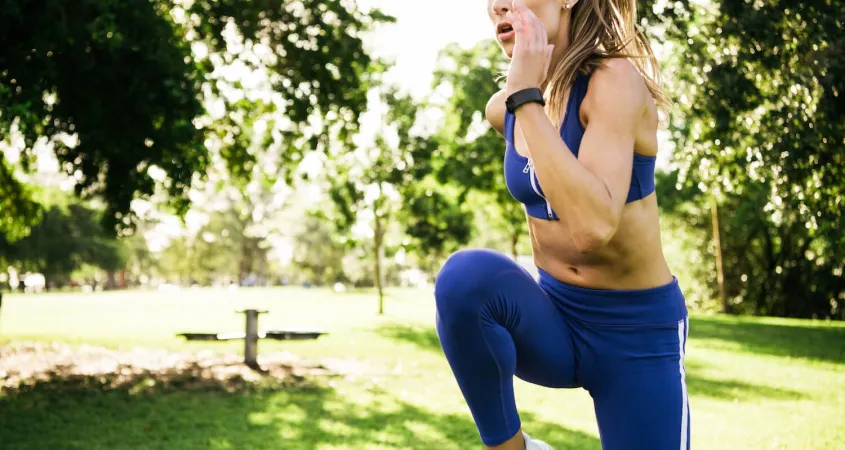
You may know that strength training is a great workout for your muscles and bones, but did you know it can also boost running performance?
Whether you use free weights, weight machines, resistance bands, or your body weight, resistance training creates strong, powerful muscles capable of producing more force with less effort. An advantage of this is an improved running economy, or how much energy you have to use to sustain your pace, per research. Or put more simply, more strength means better running performance.
In one review and meta-analysis, middle and long-distance runners saw significant improvements in running economy after strength training at least twice a week for 8 to 12 weeks. The strength routines varied between studies but included lifting heavy loads (85 percent of one-repetition maximum, or the maximum weight lifted for a single rep), low and moderate loads (40 to 70 percent of one-rep max), and performing bodyweight plyometric (jump) exercises.
Strength training also tends to help with running form, which can help safeguard your body against overuse injury in typical hot spots like the knee, shin, ankle, or foot.
“Strong muscles are crucial for promoting optimal balance during a run and help properly align the spine, pelvis, and lower body,” says Greg Westmoreland, MD, a board-certified orthopedic surgeon and sports medicine physician at Texas Orthopedics in Austin.
You’re less likely to overload your joints, muscles, and connective tissues — a common precursor to running injuries — when all your running muscles are strong and able to contribute their fair share of effort and your spine, pelvis, and lower body are properly stacked.
So, which muscles should you focus on? Brace yourself, because there are a lot of them.
According to Frankie Ruiz, chief running officer at Life Time and cofounder of the Life Time Miami Marathon, running engages the core (the muscles in your abdomen and lower back), hip flexors (the muscles in front of your hips), glutes (the meaty part of your buttocks), quads (the muscles in front of your thighs), and calves.
Targeting each of these muscles in a strength training routine can benefit your running. For example, strong glutes keep your knees from collapsing inward (known as knee valgus) during a run, helping stave off injury to the anterior cruciate ligament (ACL, a ligament in the knee joint), research finds.
Meanwhile, a study of 21 college athletes found that those who did three core-training sessions per week for eight weeks saw improvements in VO2 max (how much oxygen runners had available during exercise).
Ruiz recommends the following seven strength exercises for runners. Do these exercises before your run, after your run, or on a nonrunning day, Ruiz says. Perform as many repetitions of an exercise as possible with the correct form for one to two minutes. Then, immediately move on to the next exercise. Once you’ve completed all the exercises, return to the beginning and repeat the routine (two sets total). Do this routine at least twice a week on nonconsecutive days to target the muscles that support solid running technique.
1. Push-Up
Get on the floor on your hands and knees; stack your shoulders over your wrists and your hips over your knees. Step back with one foot and then the other so your legs are extended (straight) behind you and your feet are propped up on your toes. Engage your abdominal muscles by pulling your belly button in towards your spine.
To initiate a push-up, bend your elbows out to your sides at a 45-degree angle and lower the chest toward the floor. Touch your chest to the floor (if you can). Then, push your palms into the floor to straighten your elbows and return to the starting position.
Maintain a straight line from the crown of your head to your heels throughout the movement; don’t let your lower back sag or your glutes pop up. If floor push-ups are too challenging, perform the exercise with your knees on the ground or elevate your hands on a stable surface like a bench or chair.
2. Superman Back Extension
Lie flat on your stomach with your legs extended behind you and your arms reaching overhead. Rest your forehead and arms on the floor. Inhale deeply. On the exhale, lift your arms, chest, and legs off the ground simultaneously, keeping your hips pressed to the floor and neck in line with the spine. Squeeze your glutes and hold your arms, chest, and legs in the air for a breath or two before lowering them to the floor with control.
3. Lying Leg Raises
Lie on your back with your arms at your sides and legs extended. Press your lower back into the floor and touch your legs and feet together. Keeping your lower back pressed into the floor, squeeze your legs together and lift them several inches off the floor with your toes pointed. Engage your abdominals and, with your legs still squeezing together, lower them toward the floor. Stop when you feel the urge to lift your lower back off the floor. Then, lift your legs, trying not to tap your feet on the floor between repetitions.
4. Double-Leg Jumps With Jump Rope
Hold one handle of a jump rope in each hand and stand with feet hip-width apart, jump rope on the floor behind your feet. Stand tall and tuck your elbows close to your torso, arms bent about 45 degrees and hands angled slightly away from your hips. Rotate your wrists to bring the jump rope overhead and in front of your body. Just before the jump rope touches the floor, jump with both feet so the jump rope passes beneath. Land softly on the balls of your feet with a slight bend in the knees.
To make the exercise harder, jump with one leg at a time, keeping the other foot off the ground the whole time.
If you’re unsure whether the jump rope is the right length, the American Council on Exercise (ACE) suggests this trick to check: Stand in the middle of the jump rope and bring the handles to your armpits. If the handles reach higher than your armpits, cut or tie the rope so the handles touch your armpits. If the handles don’t reach your armpits, you need a longer jump rope.
5. Glute Bridge
Lie on your back with your arms down by your sides. Bend your knees and place both feet flat on the floor, hip-width apart. Your heels should be about six to eight inches away from your glutes and toes pointed forward. Engage your abdominals and squeeze your glutes to lift your hips toward the ceiling. Only lift your hips as high as you can without arching your back; your body should form a straight line from your knees to your hips to your shoulders. Squeeze your glutes in the top position for two seconds before slowly lowering the hips to the floor.
6. Calf Raises
Stand on the floor or on a stable step or bench next to a wall with feet hip-width apart, toes pointed forward. If you’re on a raised surface, carefully step back so your heels drop off the edge and you’re standing on the balls of your feet. Lightly place one or both hands on the wall for balance.
Raise both heels until you’re standing on your toes. Squeeze your calves and hold for one to two seconds before slowly lowering down. If you’re on a step or bench, lower your heels below the surface as far as you’re comfortably able for a greater range of motion. To make the exercise harder, perform it one leg at a time or hold a dumbbell in one hand.
7. Forward-to-Reverse Lunge
Stand with feet hip-width apart and place your hands on your hips (or clasp them in front of your chest). Brace your core and step the left foot forward, bending your knees to lower your hips so your shin and thigh form a 90 degree angle (or as close to 90 degrees as you can). Push through your left foot to return to the starting position. Then, step the left foot backward, bending your knees to lower your hips so your shin and thigh form a 90 degree angle (or as close to 90 degrees as you can). Repeat with the right leg and then continue alternating between the right and left side.
Source: everydayhealth
#Strength #Exercises #Runners



